-
Posts
25 -
Joined
-
Last visited
Content Type
Forums
Detector Prospector Home
Detector Database
Downloads
Posts posted by glabelle
-
-
1 hour ago, WesD said:
You can look up the claims here: http://www.mylandmatters.org/Maps/ClaimsNv/GetMap
Excellent! That's what I was looking for. Thanks!
-
I'm planning a trip to the Rye Patch in Nevada this year.
I have some questions regarding the area and usable detectors.1) I understand that there is a split of ownership between BLM and a railroad.
Is it OK to detect on the railroad's land?2) I understand some of the BLM land has claims on it which one should respect when
detecting. How do you know where the claims are?3) Is there a readily available map
of the area showing the claims and coordinates?4) How is the mineralization? Do you have to use a PI or can a good VLF be just as effective?
Put another way, if you could only bring one detector, which would it be?Thanks!
George in Oregon -
Thanks. Why doesn't XP document this?
Also, I knew the Deus 1 could configure the MI-6. No mention of that in the Deus 2 manual either!?
I did discover it by accident by pushing MENU while in pinpoint.
-
Just got my Deus 2. It has V0.71 update. However I cannot find any information anywhere on what the changes are. I did see Gary's video on some of the changes to menu items, but no mention of P13 "Fast 40" and P14 "Beach P". Anyone know where I can find some documentation on all of this? Thanks, George in Oregon
-
8 hours ago, GB_Amateur said:
I'm looking forward to around-the-campfire discussions and maybe even some informal demos next month at Monte's (and Oregon Gregg's and...) WTHO in Wells, NV. I know Monte has at least two Apexes as he's said that here. I hope I'm not stepping out-of-line by saying Monte gives extra importance to separation as it's a big deal in many of his preferred detecting sites. I suspect many detectors (including a couple of mine) are going to get serious workouts over five days. Reports and stories here will follow.
Monte has said he won't be there. (He has 4 Apexes, each with a different coil!) He now lives in Texas, just got a house and it is too long of a drive for him in his condition.
I'll be there 😁 I'll be bringing the Apex, the EQ800, Fisher F5 and the Impact. I can tell you that I've done much testing in ghost town conditions, and the name of the game is SMALL coil and separation speed due to the "masks" of nails and rusted tin. I've found the Classic III with Mr. Bill's mods to be an excellent performer in those conditions, only because it has a 3.5" concentric coil (Blue Max 350).
-
Put them in distilled water and thoroughly soak. Then dry completely, they should be OK.
-
Try this. Works great for me.
https://www.amazon.com/gp/product/B00AU6G64S/ref=ppx_yo_dt_b_search_asin_title?ie=UTF8&psc=1
WB6YZZ
-
Try rubbing the contacts (very lightly) with a pencil eraser.
-
An explanation of how VLF detectors work may be in order.
When a target upsets the null between the Tx and Rx coils, there is a signal read which has a phase shift and an amplitude amount. It is the ratio between this phase shift and amplitude that is used to analyze what that target may be. A clad penny, or a silver dime, or a nickel, always has the same ratio. The ground also has a ratio - this is why you "ground balance". To ignore this particular ratio, given what environment you are in.
-
3 hours ago, Rich (Utah) said:
Chase,
Some good thoughts.
Recapping / Rewording of some of my thoughts.
A Ground Balance Setting of 0 = The standard Ground balance is OFF and the detector is using Minelabs' signal analytics to separate targets from the ground signal. As I read it, Minelab believes this method provides SUPERIOR performance when compared to the standard Ground Balancing Method.
Second, AT SOME POINT when the ground signal is too great, that advantage is LOST and Minelab recommends that you engage the standard ground balance system by changing the Ground Balance number to anything other than 0.
Minelab does not tell us the exact point where their system is no longer superior, (i.e. a ground balance of number of 80 or 85 or 90) but simply tells us that we will recognize it when we begin to get Ground Noise. Rather vague. It would be nice to know where this transition occurs. Still, I have yet to experience ground noise while using my 800 and I live out West.
A Ground Balance setting of '0' is not a 'Dummy Setting' for noobs. It is not what we might compare to a detector with a factory SET ground balance level that works pretty good in MOST situations. A Ground balance setting of '0' simply means the Equinox is using Minelabs' signal analytics to separate the ground signal from possible targets.
An additional thought here that you brought up about hunting with the HORSESHOE or 'No Discrimination' engaged. Earlier in the year, MKUS from the findmall forum was praising using this for the majority of his hunting and suggested those reading his post to give it a try. I believe his thoughts are worth a look.
Again, best of luck to all of you in the field.
Rich (Utah)
Rich, ground balance (a setting to ignore the ground) is *always* "on" in any VLF machine. Think more of a ground balance of "0" as the same as a general ground balance set in a Tesoro machine. It is a fixed average, determined by the Minelab engineers. The way they analyze the target in software, they think they know how to separate ground noise - and well they may in many conditions. In many of their machines, Tesoro simply set a fixed "average" value (whatever that is) for mineralization. This would be akin to Minelab's "0" ground balance. Some of Tesoro's machines had an external control, many were "fixed" internally. I think it was a selling point - simplification for the user! You *can* get away without exact ground balance, but you lose that little bit of extra sensitivity. Another classic (so to speak ? ) case is the Classic series from Whites. There was no ground balance control (actually there was a trim pot located under the American flag sticker that you could adjust) - it was set internally (with that trimmer) to some "average" value. Mr. Bill's modification added a ground balance control knob to that unit, which improved sensitivity. Ironic, since I just completed that mod myself on a Classic III today! I'll show it to you in Nevada.
I was doing some testing with my 800 today. A ground balance of "0" results is a big positive signal when the coil is lowered to my moderately mineralized test bed. If I do an auto balance, it ends up on "6". Then when in all metal/pinpoint, there is no change in tone when the coil is lowered to the ground. That, to me, is the proper way to set up a detector.
I downloaded and read that CT-3030 manual. I noticed there is no mention of ground "tracking" in it. I believe their 2 settings, "Start ground balance" and "enable ground" on, refer to manually ground balancing, and when enabled, ground TRACKING. That's why it would not be recommended in lightly mineralized soils. I NEVER use tracking. Don't trust it. I sweep over a target fast+slow+ and every which way, zeroing in on it. There's too much chance of "tracking out" a weak target. The reason it is default in the gold modes, is that the ground in gold areas is usually heavily mineralized and varying, such that you have to track in order to eliminate ground noise and pick up those little "pickers". I admit, I've never done nugget hunting, but I understand the principles.
-
I completely agree with Chase. Unless you have "0" ground condition, it cannot hurt to ground balance to obtain the maximum sensitivity to a target other than the ground. It also helps when pinpointing - especially a very weak target. When you pinpoint, you should hear no signal when the coil approaches the ground. If the GB is not correct, you could lose a weak target, either by getting a positive or a negative signal from the ground.
-
6 hours ago, Chase Goldman said:
Just one comment here, even though ML is not revealing the secret sauce on how it transmits and processes simultaneous multi frequencies, it has been pretty well established by various third party measurements (see this thread and the links within), that Equinox is likely only simultaneously transmitting two frequencies at a time.
With all due respect to GEOTECH (I've met him), he was measuring the waveform on the coil with an oscilloscope. That is a difficult way to determine how many frequencies are present. The best way to "see" multiple frequencies is with a spectrum analyzer. That is what I did. I used a pickup coil near the detector coil to receive whatever was being transmitted. When in "Multi", there are several (more than 2) frequencies being transmitted. I'm certain, the "secret sauce" is in how the receive signal is processed. You can see this in the diagrams below. The X axis is frequency (1KHz - 50KHz). Multiple frequencies are evident.
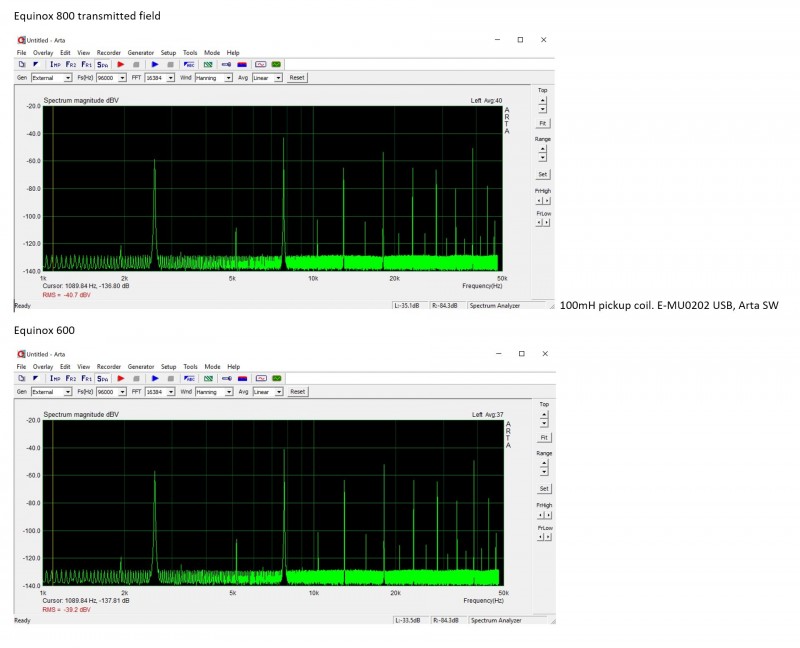
-
On 4/19/2019 at 11:54 AM, Flowdog said:
Does the Recovery speed adjustment set a fixed number of Tx and Rx cycles over a given period of time (something like the variable speed conveyor belt analogy Steve wrote elsewhere)?
This is probably pretty close.
Remember, in the Equinox, all the analysis of a signal takes place in software. Naturally, this is Minelab's proprietary intellectual property, so we don't know exactly what they are doing. Being a retired SW engineer, I can venture a couple of guesses.
One thing they could do is spend more time, and obtain more VID accuracy when analyzing a signal when in a slow recovery mode. If you demand increased recovery speed, they might a) Spend less time in the function that analyzes the data, or b) analyze less than all 5 frequencies, or c)?
-
17 minutes ago, 1848cal said:
Hi. I just received my EQX800 last week, charged the batteries, synced the WM08, ML80 and the EQX800 without difficulty and, of course this was preformed indoors. The problem I’m experiencing is there is no audible/sound emitting from the external speaker, nothing, silent. The cable is secure and correct, all components are at peak battery charge and the ML80 functions properly. I’ve disconnected wi-fi, checked and rechecked the volume adjust, factory reset both the EQX and the ML80, paired the components two or more times (without any issues and functioning properly) yet still no sound emitting from the speaker, not even the slightest sound. I look forward to any and all responses in hopes to resolve my dilemma. Thanks
Once you pair with wireless phones, or plug in headphones, the speaker is disabled.
-
-
Indeed, I was just starting to attempt to measure the output from my 800. The analyzer I was using didn't go up to 40KHz, which negated the validity of the test in the first place. The 800 was also in 15KHz mode, therefore the 1 freq. on Park 1. I thought I'd publish this as an April 1st measurement as I figured it might freak some out ?
Anyway, I did get a reasonable test configuration setup and measured the transmit field. In Multi-IQ, it does put out multiple frequencies in ALL modes. Obviously, the magic and "weighting" takes place in the SW of the receiver.
The graph included is the output for all the detecting modes.
-
-
Steve, before you take it into the water, you may want to read this. http://md-hunter.com/minelab-equinox-battery-doesnt-work-water-in-battery-compartment/#more-13500
I would put some silicone grease in the appropriate places before submerging it.
George
-
3 minutes ago, Steve Herschbach said:
FE Volume is not the same thing as Iron Bias. You have FE Volume on the 600 also if that is your preference.
Iron Bias changes how the detector actually detector ferrous items and helps control ferrous falsing. FE Volume is nothing more than a volume control for ferrous responses and has no effect on ferrous false signals.
Thanks Steve, I have a look at Fe vol. on the EQ. I knew that IB was a different way of analyzing the target - but it seems to reduce overall sensitivity/depth. Is that your experience as well?
-
17 hours ago, Steve Herschbach said:
Yes, that is all normal except the part where VDI does not matter. It does.
There is a very common and and ongoing commentary about target id numbers that where it seems to me that people think detectors put good stuff and bad stuff into neat and tidy compartments with no overlap. It simply does not work that way. For every good item there is a trash item that reads the same. It is all about percentages and odds.
Absolutely right Steve. The worst kind of "wrap around" is when the machine detects a deep (at the limit of detection) small silver coin as iron. I experienced this with the X-terra. I've heard this occurs with other machines as well. The V3i did it. I have a new Minelab EQ600 and a Nokta Impact, but have not run depth tests as yet, since I'm going on a ghost town trip this week, and am concentrating on separating coins from iron trash.
The little testing I have performed shows that the Impact with a 5" DD coil is superior, in dense iron trash, to the EQ600 - because the only coil available is the 11". I think with the 6" coil it will be fine.
I really like the "Fe volume" setting on the Impact. It may turn out to be more useful than "iron bias" on the EQ600, since it appears that you lose sensitivity with increasing iron bias.
George
-
That does look good!
Can you share any tips/tricks for cutting and drilling the carbon fiber?
-
Yes. The 1/8" plug is not seating well in the headphone socket. I noticed this right away with my 600 and provided phones.
To have the headphone cable hanging out of the detector head is a bad swivel point in my estimation. What I did was put a 1/8" male to male cord into the detector control box, and string it along the bottom of the shaft to below the arm cup, where I tie wrapped a female to female adapter. Now the phones cord comes out of the back of the detector shaft in a much better position for swinging. It is solid enough to put a 1/8" - /14" male-male adapter for other headphones as well.
-
24 minutes ago, Steve Herschbach said:
There is a piece of gold jewelry that perfectly emulates the signal from every bit of aluminum trash made. No VDI number and no meter can separate them. Reject one, you reject the other. That’s just a fact.
Tell me about it. Discrimination, or at least TID numbers can be your worst enemy. I have to recall one of the best finds I ever made:
It was in the early 80's, I was in Palo Alto at lunch from Hewlett Packard with a friend to demonstrate my Whites 6000 Di SIII. It had the big TID meter on it, which I thought I was proficient at reading. We were at a relatively small and new park, when I hit a large signal. I told my friend, confidently, that's a screwcap. Had I been alone, I would have kept moving along and left the "screwcap". Instead to prove my proficiency at IDing items, we pried it up from about a 1/2" down. It was a large University of Santa Barbara college class ring. 14C gold. Yowsa. I learned a valuable lesson from that experience.


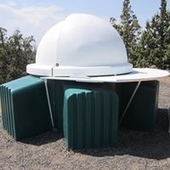
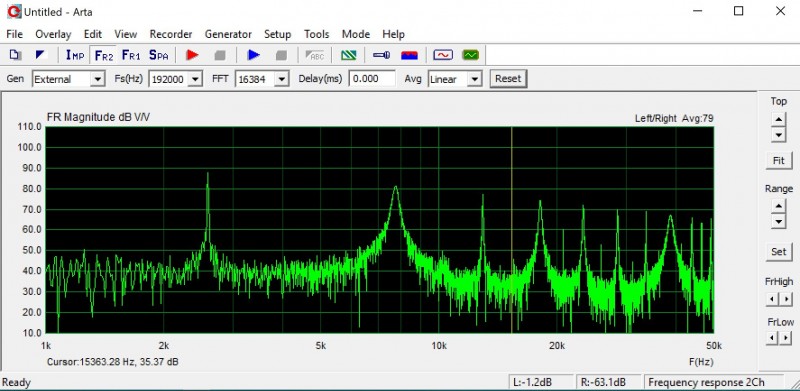
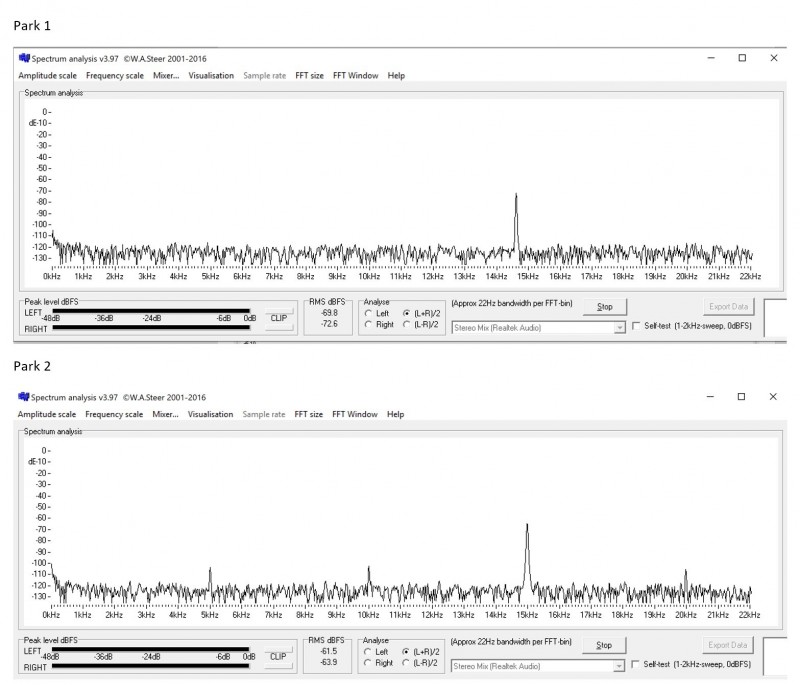
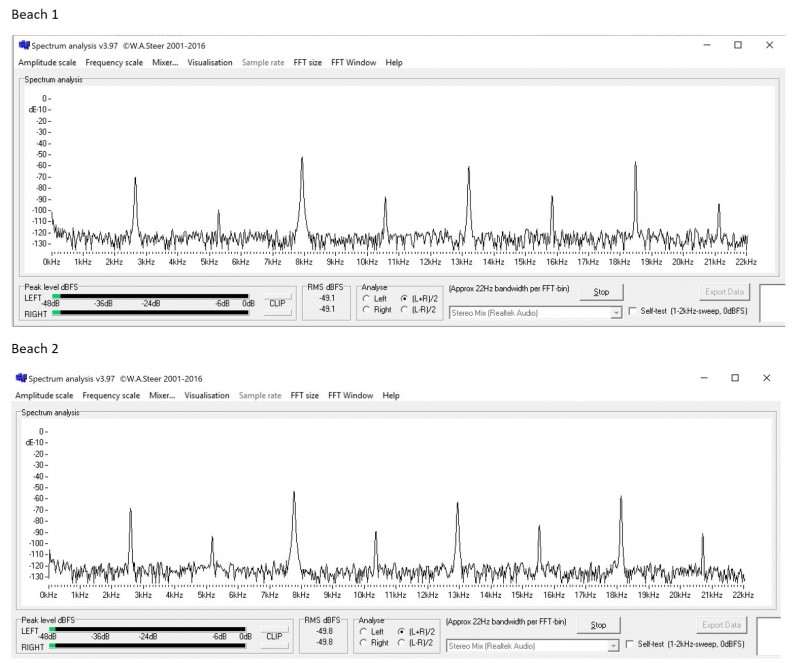
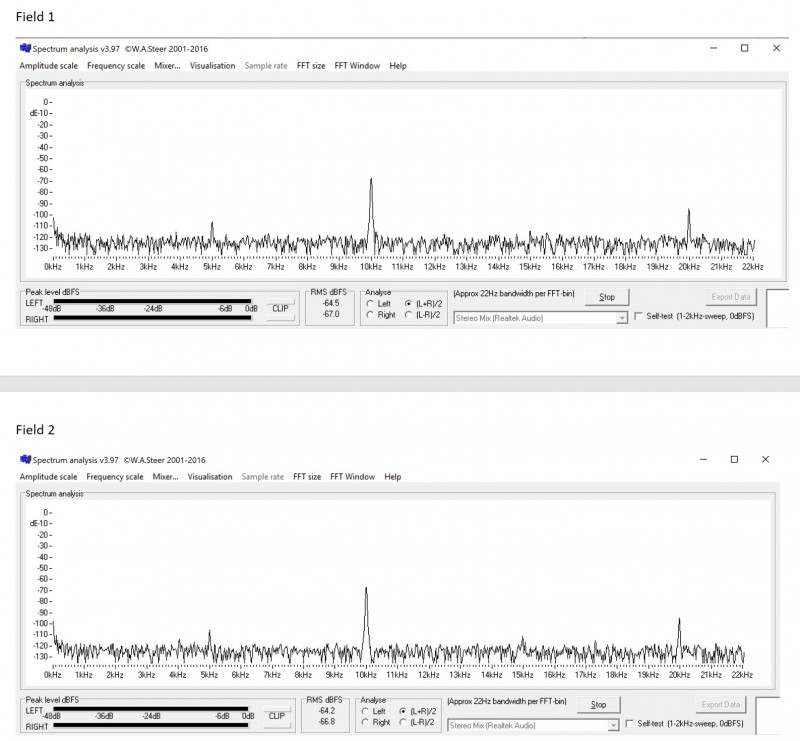
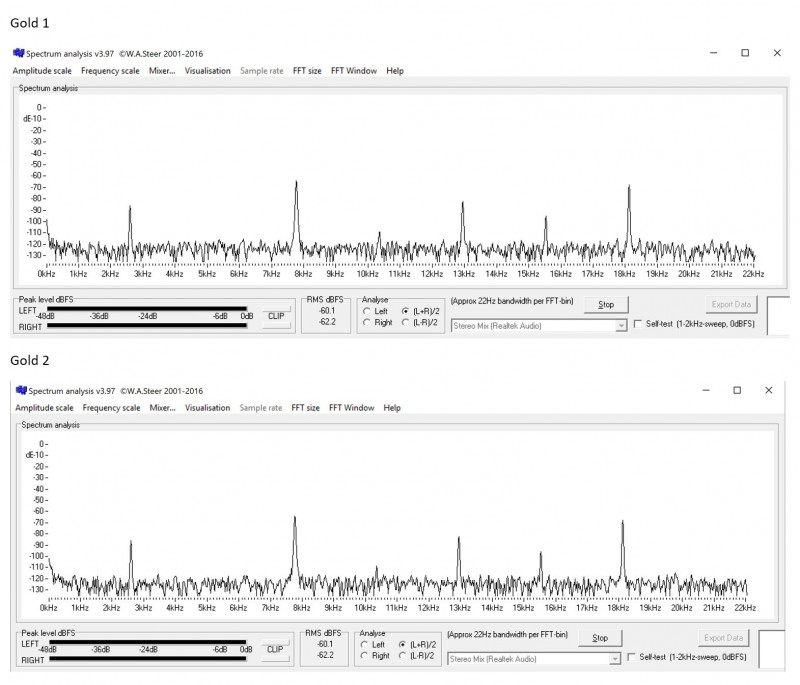
Titan Ger 1000
in Metal Detector Advice & Comparisons
Posted
Have you tried it and it WORKED???